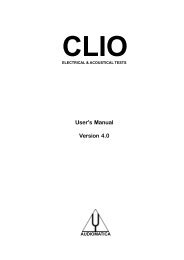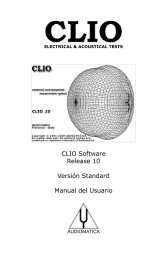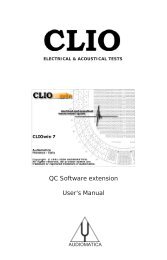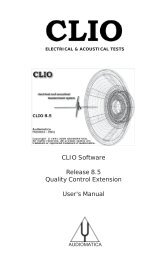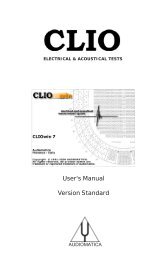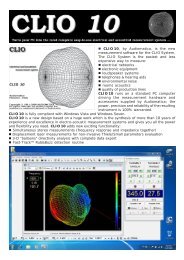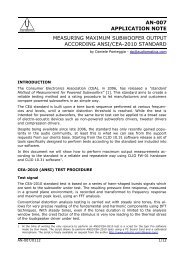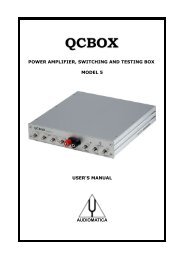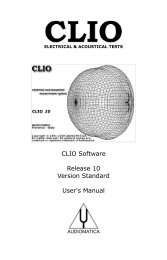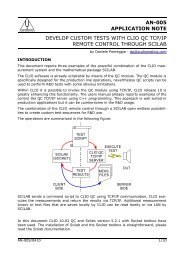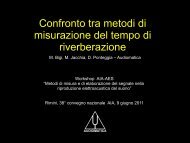CLIOwin 6.5 PCI User's Manual - Audiomatica Srl
CLIOwin 6.5 PCI User's Manual - Audiomatica Srl
CLIOwin 6.5 PCI User's Manual - Audiomatica Srl
You also want an ePaper? Increase the reach of your titles
YUMPU automatically turns print PDFs into web optimized ePapers that Google loves.
13 MEASURING IMPEDANCE AND T&S PARAMETERS<br />
13.1 INTRODUCTION<br />
This chapter deals, before going in the Thiele and Small Parameters Menu description,<br />
with impedance measurements in general. CLIO performs impedance vs. frequency<br />
measurements both from within the MLS and the Sinusoidal Menu. You will find specific<br />
information in the relative Chapters. Both are relevant to what we will explain now. Here<br />
we explain connections, principles and other topics that apply to both menus.<br />
Differences and choice criteria are also covered.<br />
13.2 GENERALS<br />
Whatever the stimuli, CLIO sees a voltage at its input. Impedance is obtained by a<br />
suitable post process, which changes upon how user decides to perform the measurement.<br />
Four methods are available. Two of them, Internal and I Sense, were already<br />
found in the Settings Dialog, both in MLS and Sinusoidal. We will start with these, leaving<br />
Constant Voltage and Constant Current to later on. The last two methods derive<br />
their name from the description of what is going on during the measurement; they were<br />
the standard before automatic computer based Measuring Systems. Internal and I<br />
Sense are faster, require only one measure, it is easier to handle the connections<br />
needed.<br />
13.3 INTERNAL MODE<br />
CLIO<br />
INPUT A<br />
INPUT B<br />
OUTPUT A<br />
OUTPUT B<br />
ZX<br />
Figure 13.1<br />
In principle, Internal mode is very similar to Constant Current. Takes advantage on<br />
the knowledge CLIO has of its own output level and output impedance (150 Ohm 0.1%).<br />
In fact, this value is lower than what should be used for true Constant Current<br />
procedure. Veterans should not worry; Even if the resistor value is on the same order<br />
of magnitude of the device you are going to measure instead of 10 times higher as<br />
usually advised, no errors occurs as CLIO is able to acquire and evaluate the signal at<br />
device terminals as complex (real and imaginary). Fig.13.1 shows the connections for<br />
measuring Impedance in Internal mode. Only one cables (pin-to-alligators like the one<br />
in the photo) needed, without any other external active or passive device. Before<br />
starting any impedance measurement in Internal Mode remember to switch on the<br />
loop button ( or ) of the channel you are going to use.<br />
Chapter 13 - Measuring impedance and T&S parameters 127



